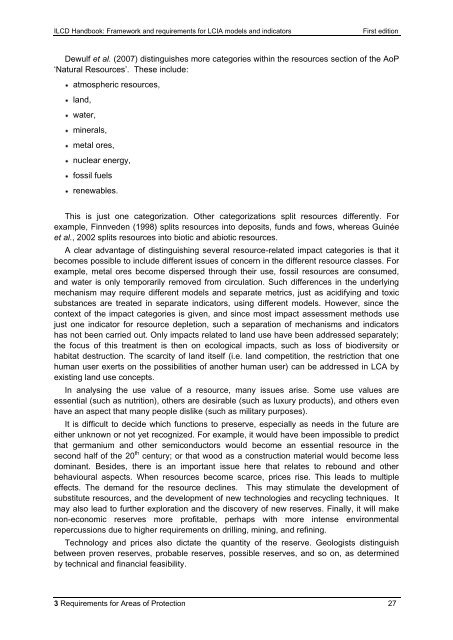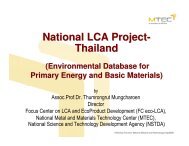ILCD Handbook: Framework and requirements for LCIA models and ...
ILCD Handbook: Framework and requirements for LCIA models and ...
ILCD Handbook: Framework and requirements for LCIA models and ...
Create successful ePaper yourself
Turn your PDF publications into a flip-book with our unique Google optimized e-Paper software.
<strong>ILCD</strong> <strong>H<strong>and</strong>book</strong>: <strong>Framework</strong> <strong>and</strong> <strong>requirements</strong> <strong>for</strong> <strong>LCIA</strong> <strong>models</strong> <strong>and</strong> indicators First edition<br />
Dewulf et al. (2007) distinguishes more categories within the resources section of the AoP<br />
‗Natural Resources‘. These include:<br />
atmospheric resources,<br />
l<strong>and</strong>,<br />
water,<br />
minerals,<br />
metal ores,<br />
nuclear energy,<br />
fossil fuels<br />
renewables.<br />
This is just one categorization. Other categorizations split resources differently. For<br />
example, Finnveden (1998) splits resources into deposits, funds <strong>and</strong> fows, whereas Guinée<br />
et al., 2002 splits resources into biotic <strong>and</strong> abiotic resources.<br />
A clear advantage of distinguishing several resource-related impact categories is that it<br />
becomes possible to include different issues of concern in the different resource classes. For<br />
example, metal ores become dispersed through their use, fossil resources are consumed,<br />
<strong>and</strong> water is only temporarily removed from circulation. Such differences in the underlying<br />
mechanism may require different <strong>models</strong> <strong>and</strong> separate metrics, just as acidifying <strong>and</strong> toxic<br />
substances are treated in separate indicators, using different <strong>models</strong>. However, since the<br />
context of the impact categories is given, <strong>and</strong> since most impact assessment methods use<br />
just one indicator <strong>for</strong> resource depletion, such a separation of mechanisms <strong>and</strong> indicators<br />
has not been carried out. Only impacts related to l<strong>and</strong> use have been addressed separately;<br />
the focus of this treatment is then on ecological impacts, such as loss of biodiversity or<br />
habitat destruction. The scarcity of l<strong>and</strong> itself (i.e. l<strong>and</strong> competition, the restriction that one<br />
human user exerts on the possibilities of another human user) can be addressed in LCA by<br />
existing l<strong>and</strong> use concepts.<br />
In analysing the use value of a resource, many issues arise. Some use values are<br />
essential (such as nutrition), others are desirable (such as luxury products), <strong>and</strong> others even<br />
have an aspect that many people dislike (such as military purposes).<br />
It is difficult to decide which functions to preserve, especially as needs in the future are<br />
either unknown or not yet recognized. For example, it would have been impossible to predict<br />
that germanium <strong>and</strong> other semiconductors would become an essential resource in the<br />
second half of the 20 th century; or that wood as a construction material would become less<br />
dominant. Besides, there is an important issue here that relates to rebound <strong>and</strong> other<br />
behavioural aspects. When resources become scarce, prices rise. This leads to multiple<br />
effects. The dem<strong>and</strong> <strong>for</strong> the resource declines. This may stimulate the development of<br />
substitute resources, <strong>and</strong> the development of new technologies <strong>and</strong> recycling techniques. It<br />
may also lead to further exploration <strong>and</strong> the discovery of new reserves. Finally, it will make<br />
non-economic reserves more profitable, perhaps with more intense environmental<br />
repercussions due to higher <strong>requirements</strong> on drilling, mining, <strong>and</strong> refining.<br />
Technology <strong>and</strong> prices also dictate the quantity of the reserve. Geologists distinguish<br />
between proven reserves, probable reserves, possible reserves, <strong>and</strong> so on, as determined<br />
by technical <strong>and</strong> financial feasibility.<br />
3 Requirements <strong>for</strong> Areas of Protection 27



